PONTIAC FIERO 1988 Service Repair Manual
Manufacturer: PONTIAC, Model Year: 1988, Model line: FIERO, Model: PONTIAC FIERO 1988Pages: 1825, PDF Size: 99.44 MB
Page 321 of 1825

Page 322 of 1825
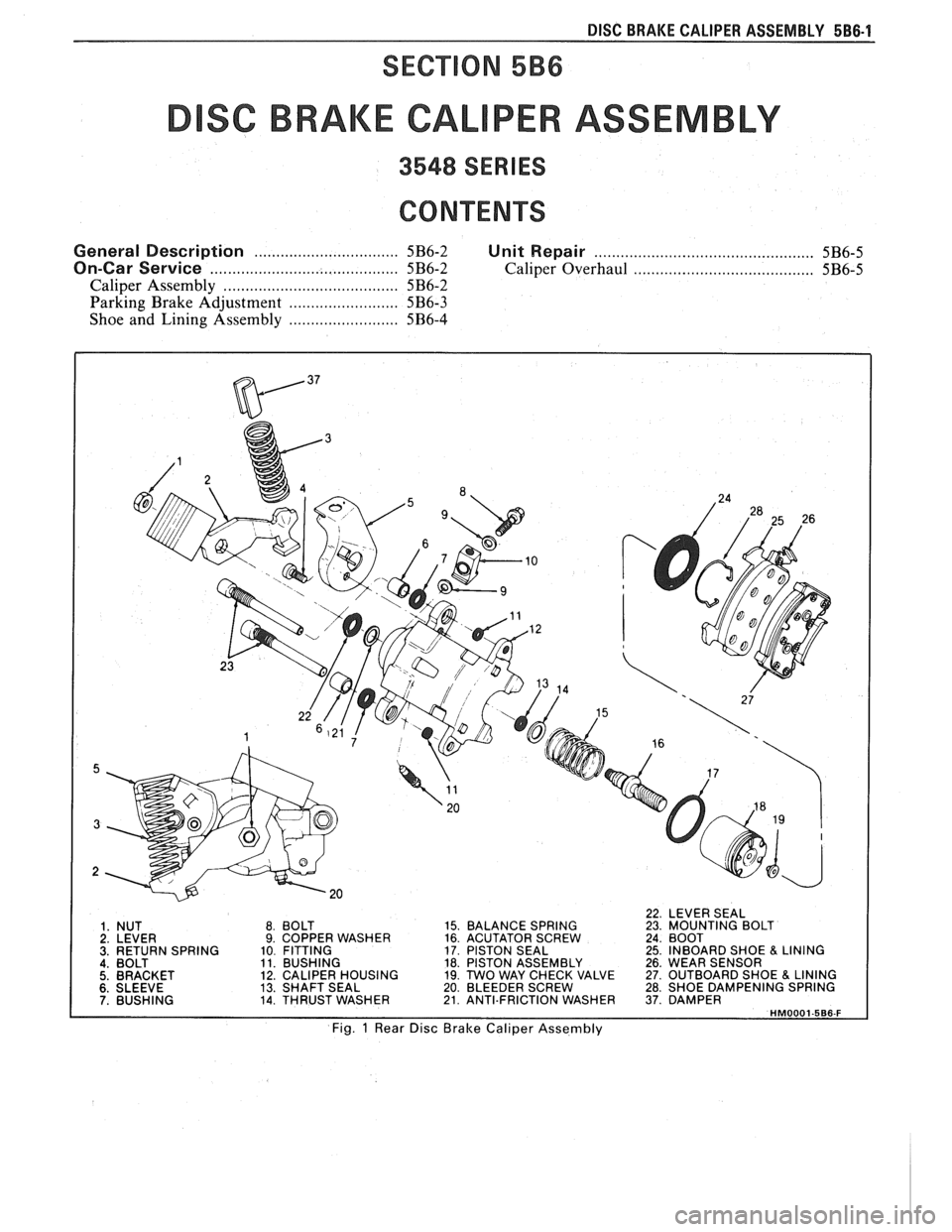
DISC BRAKE CALIPER ASSEMBLY 586-1
SEC"619RI 5B6
SC BRAKE CAL PER ASSEMBLY
3548 SERIES
CONTENTS
General Description ................................. 5B6-2 Unit Repair ........................................... 5B6-5
On-Car Service ........................................ 5B6-2 Caliper Overhaul ....................................... 5B6-5
Caliper Assembly ....................................... 5B6-2
Parking Brake Adjustment ......................... 5B6-3
Shoe and Lining Assembly ......................... 5B6-4
22 LEVER SEAL
1. NUT
2. LEVER
3. RETURN SPRING 4. BOLT 5. BRACKET 8.
BOLT 15.
BALANCE SPRING
23. MOUNT~NG BOLT 9. COPPER WASHER 16. ACUTATOR SCREW 24. BOOT
10 FITTING 17.
PISTON SEAL 25. INBOARD SHOE & LINING 11. BUSHING 18. PISTON ASSEMBLY 26. WEAR SENSOR
12. CALIPER HOUSING 19. TWO
WAY CHECK VALVE 27. OUTBOARD SHOE & LINING 6. SLEEVE 13. SHAFT SEAL 20. BLEEDER SCREW 28. SHOE DAMPENING SPRING 7. BUSHING 14. THRUST WASHER 21. ANTI.FRICTION WASHER 37. DAMPER HM0001-566-F
Fig. 1 Rear Disc Brake Caliper Assembly
Page 323 of 1825
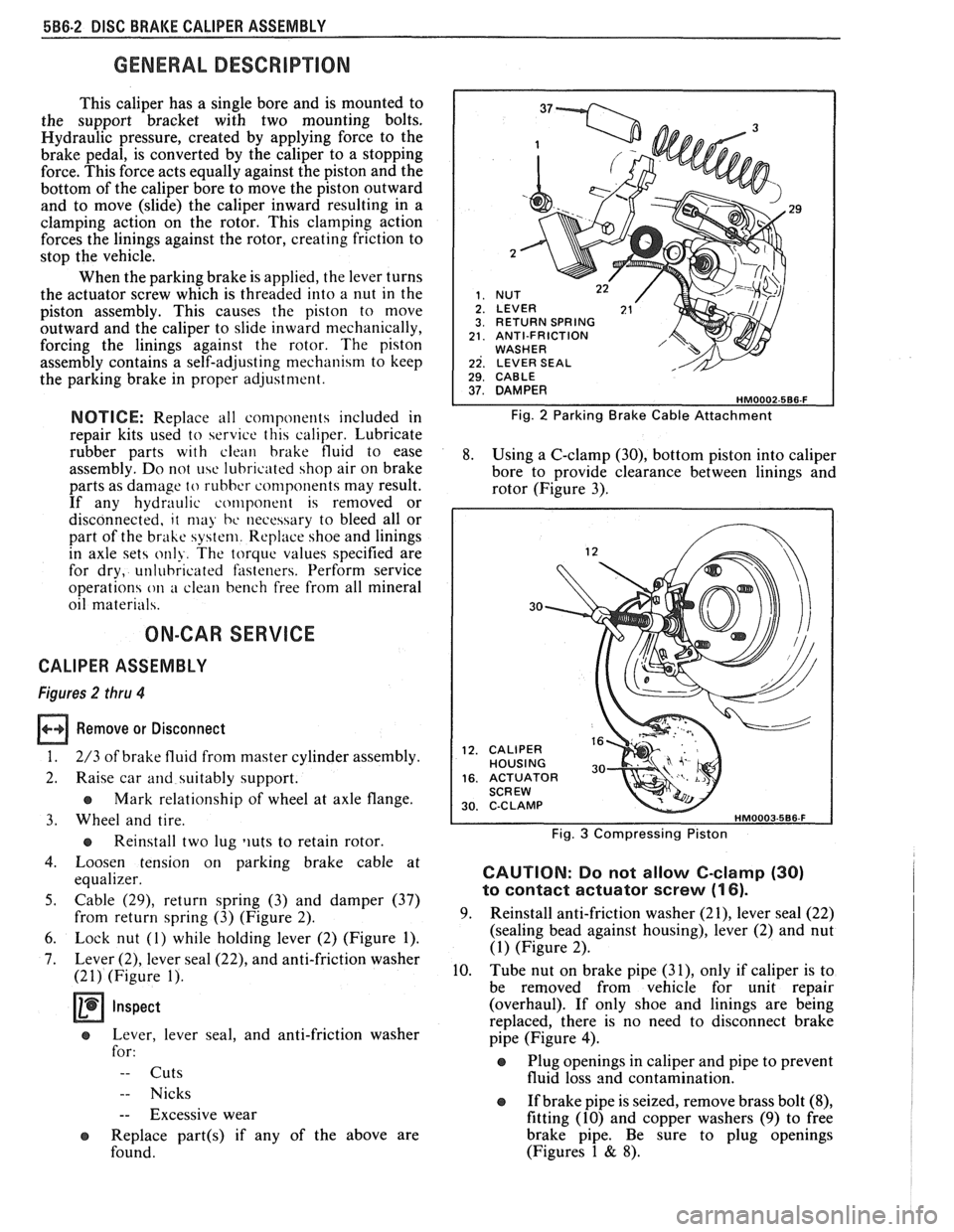
586.2 DISC BRAKE CALIPER ASSEMBLY
GENERAL DESCRIPUON
This caliper has a single bore and is mounted to
the support bracket with two mounting bolts.
Hydraulic pressure, created by applying force to the
brake pedal, is converted by the caliper to a stopping
force. This force acts equally against the piston and the
bottom of the caliper bore to move the piston outward
and to move (slide) the caliper inward resulting in a
clamping action on the rotor. This clamping action
forces the linings against the rotor, creating friction to
stop the vehicle.
When the parking brake is applied, the lever turns
the actuator screw which is threaded into a nut in the
piston assembly. This causes the piston to move
outward and the caliper to slide inward mechanically,
forcing the linings against the rotor. The piston
assembly contains a self-adjusting mechanism to keep
the parking brake in proper adjustment.
NOTICE: Replace all components included in
repair kits used to service this caliper. Lubricate
rubber parts with clean brake fluid to ease
assembly. Do not
uhe lubricated shop air on brake
parts as damage to rubber components may result.
If any hydraulic
coniponent is removed or
disconnected,
it may he necessary to bleed all or
part of the brake system. Replace shoe and linings
in axle sets only. The torque values specified are
for dry,
unlubricated fasteners. Perform service
operations
011 a clean bench free from all mineral
oil materials.
ON-CAR SERVICE
CALIPER ASSEMBLY
Figures 2 thru 4
Remove or Disconnect
1. 2/3 of brake fluid from master cylinder assembly.
2. Raise car and suitably support.
e Mark relationship of wheel at axle flange.
3. Wheel and tire.
e Reinstall two lug liuts to retain rotor.
4. Loosen tension on parking brake cable at
equalizer.
5. Cable (29), return spring (3) and damper (37)
from return spring (3) (Figure 2).
6. Lock nut (1) while holding lever (2) (Figure 1).
7. Lever (2), lever seal (22), and anti-friction washer
(21) (Figure 1).
Inspect
e Lever, lever seal, and anti-friction washer
for:
-- Cuts
-- Nicks
-- Excessive wear
e Replace part(s) if any of the above are
found.
29
RETURN SPRING ANTI-FRICTION WASHER LEVER SEAL 1 29. CABLE I
Fig. 2 Parking Brake Cable Attachment
8. Using a C-clamp (30), bottom piston into caliper
bore to provide clearance between linings and
rotor (Figure 3).
30
CALIPER HOUSING ACTUATOR SCREW C-C LAMP
Fig. 3 Compressing Piston
CAUTION: Do not allow C-clamp (30)
to contact actuator screw (1 6).
9. Reinstall anti-friction washer (21), lever seal (22)
(sealing bead against housing), lever (2) and nut
(1) (Figure 2).
10. Tube nut on brake pipe
(31), only if caliper is to
be removed from vehicle for unit repair
(overhaul). If only shoe and linings are being
replaced, there is no need to disconnect brake
pipe (Figure
4).
Plug openings in caliper and pipe to prevent
fluid loss and contamination.
If brake pipe is seized, remove brass bolt
(8),
fitting (10) and copper washers (9) to free
brake pipe. Be sure to plug openings
(Figures 1
& 8).
Page 324 of 1825
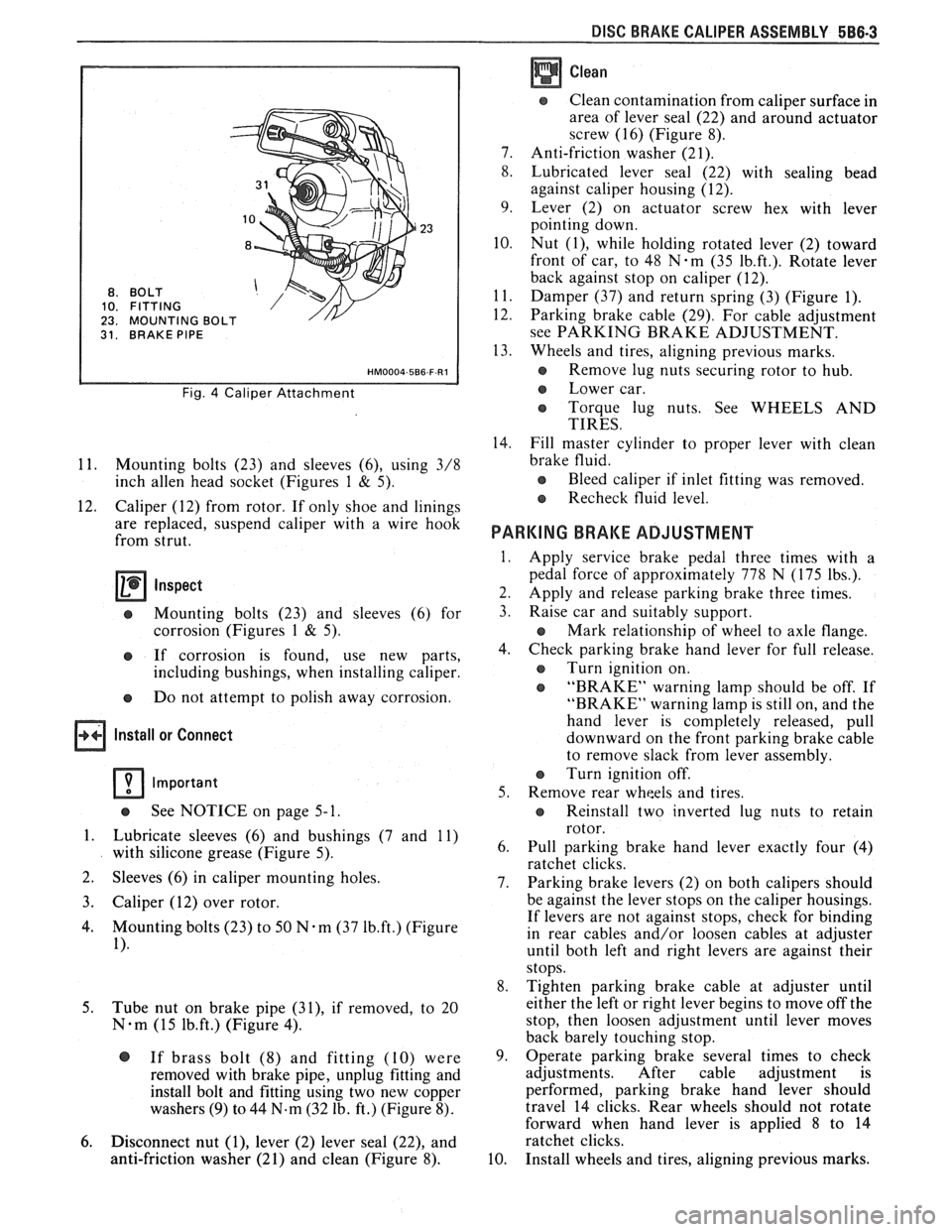
DISC BRAKE CALIPER ASSEMBLY 588-3
BO LT
FITTING
MOUNTING
31. BRAKE PIPE
Fig. 4 Caliper Attachment
11. Mounting bolts (23) and sleeves (6), using 3/8
inch
allen head socket (Figures 1 & 5).
12. Caliper (12) from rotor. If only shoe and linings
are replaced, suspend caliper with a wire hook
from strut.
Inspect
e Mounting bolts (23) and sleeves (6) for
corrosion (Figures
1 & 5).
e If corrosion is found, use new parts,
including bushings, when installing caliper.
e Do not attempt to polish away corrosion.
Install or Connect
Important
See NOTICE on page 5- 1.
1. Lubricate sleeves (6) and bushings (7 and 11)
with silicone grease (Figure 5).
2. Sleeves
(6) in caliper mounting holes.
3. Caliper (12) over rotor.
4. Mounting bolts (23) to 50 N-m (37 1b.ft.) (Figure
1).
5.
Tube nut on brake pipe (31), if removed, to 20
N-m (15 1b.ft.) (Figure 4).
@ If brass bolt (8) and fitting (10) were
removed with brake pipe, unplug fitting and
install bolt and fitting using two new copper
washers
(9) to 44 N.m (32 lb. ft.) (Figure 8).
6. Disconnect nut (I), lever (2) lever seal (22), and
anti-friction washer (21) and clean (Figure 8).
Clean
Clean contamination from caliper surface in
area of lever seal (22) and around actuator
screw (16) (Figure 8).
7. Anti-friction washer (21).
8. Lubricated lever seal (22) with sealing bead
against caliper housing (12).
9. Lever (2) on actuator screw hex with lever
pointing down.
10. Nut
(I), while holding rotated lever (2) toward
front of car, to 48
N-m (35 1b.ft.). Rotate lever
back against stop on caliper (12).
11. Damper (37) and return spring (3) (Figure 1).
12. Parking brake cable (29). For cable adjustment
see PARKING BRAKE ADJUSTMENT.
13. Wheels and tires, aligning previous marks.
s Remove lug nuts securing rotor to hub.
e Lower car.
e Torque lug nuts. See WHEELS AND
TIRES.
14. Fill master cylinder to proper lever with clean
brake fluid.
e Bleed caliper if inlet fitting was removed.
Recheck fluid level.
PARKING BRAKE ADJUSTMENT
Apply service brake pedal three times with a
pedal force of approximately 778 N (175 lbs.).
Apply and release parking brake three times.
Raise car and suitably support.
e Mark relationship of wheel to axle flange.
Check parking brake hand lever for full release.
e Turn ignition on.
e "BRAKE" warning lamp should be off. If
"BRAKE" warning lamp is still on, and the
hand lever is completely released, pull
downward on the front parking brake cable
to remove slack from lever assembly.
Turn ignition off.
Remove rear wheels and tires.
e Reinstall two inverted lug nuts to retain
rotor.
Pull parking brake hand lever exactly four (4)
ratchet clicks.
Parking brake levers (2) on both calipers should
be against the lever stops on the caliper housings.
If levers are not against stops, check for binding
in rear cables and/or loosen cables at adjuster
until both left and right levers are against their
stops.
Tighten parking brake cable at adjuster until
either the left or right lever begins to move off the
stop, then loosen adjustment until lever moves
back barely touching stop.
Operate parking brake several times to check
adjustments. After cable adjustment is
performed, parking brake hand lever should
travel 14 clicks. Rear wheels should not rotate
forward when hand lever is applied
8 to 14
ratchet clicks.
Install wheels and tires, aligning previous marks.
Page 325 of 1825
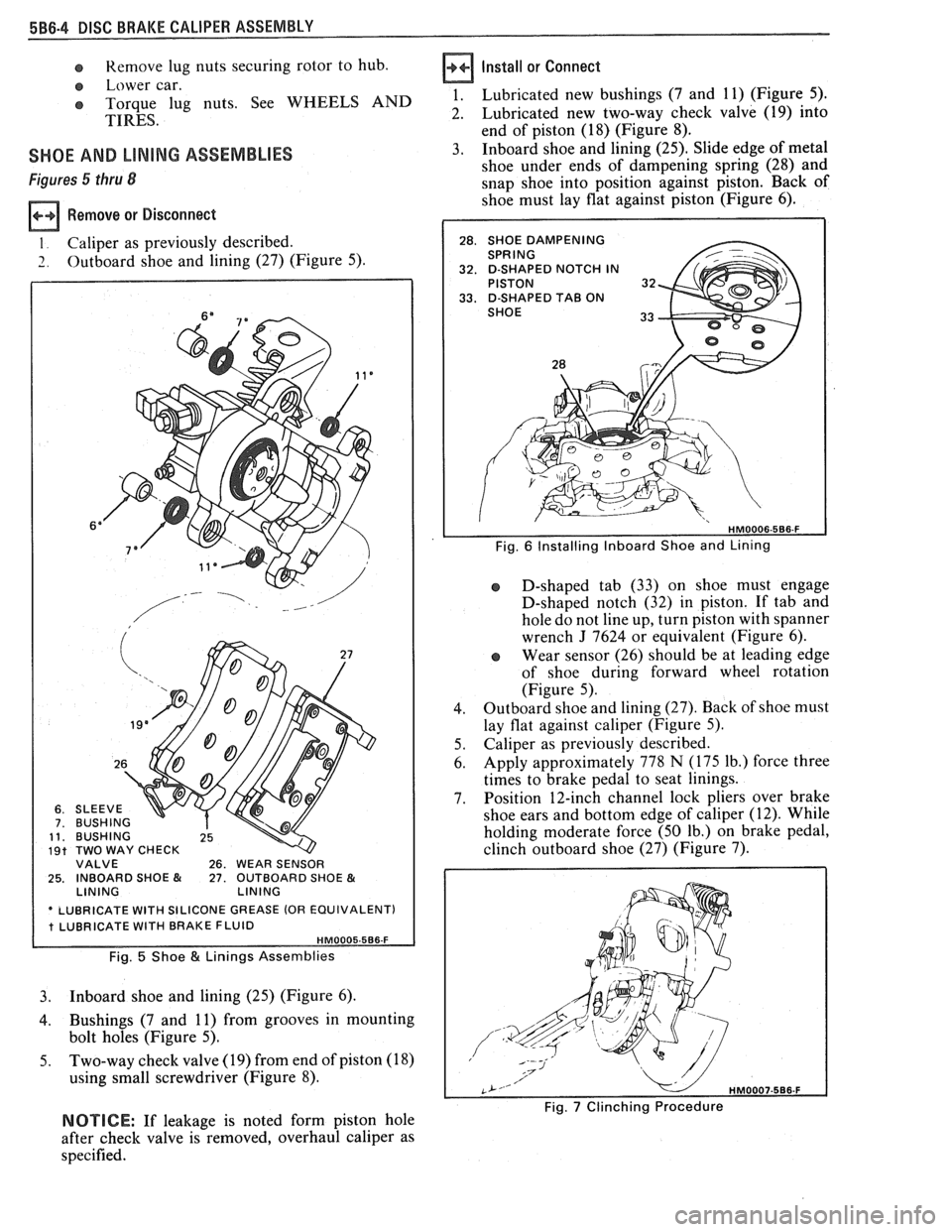
e Remove lug nuts securing rotor to hub.
e Lower car.
o Torque lug nuts. See WHEELS AND
TIRES.
SHOE AND LINING ASSEMBLIES
Figures 5 thru 8
Remove or Disconnect
1. Caliper as previously described.
2 Outboard shoe and lining (27) (Figure 5).
Install or Connect
1. Lubricated new bushings (7 and 11) (Figure 5).
2. Lubricated new two-way check valve (19) into
end of piston (18) (Figure 8).
3. Inboard shoe and lining (25). Slide edge of metal
shoe under ends of dampening spring (28) and
snap shoe into position against piston. Back of
shoe must lay flat against piston (Figure 6).
Fig. 6 Installing Inboard Shoe and Lining
26. WEAR SENSOR 25. INBOARD SHOE & 27. OUTBOARD SHOE & LINING
ASE (OR EQUIVALENT)
Fig. 5 Shoe & Linings Assemblies
3. Inboard shoe and lining (25) (Figure 6).
4. Bushings (7 and 11) from grooves in mounting
bolt holes (Figure 5).
5. Two-way check valve (19) from end of piston (18)
using small screwdriver (Figure 8). D-shaped
tab (33) on shoe must engage
D-shaped notch (32) in piston. If tab and
hole do not line up, turn piston with spanner
wrench
J 7624 or equivalent (Figure 6).
r, Wear sensor (26) should be at leading edge
of shoe during forward wheel rotation
(Figure 5).
4. Outboard
shoe and lining (27). Back of shoe must
lay flat against caliper (Figure
5).
5. Caliper as previously described.
6. Apply approximately 778
N (175 lb.) force three
times to brake pedal to seat linings.
7. Position
12-inch channel lock pliers over brake
shoe ears and bottom edge of caliper (12). While
holding moderate force
(50 lb.) on brake pedal,
clinch outboard shoe (27) (Figure 7).
NOTICE: If leakage is noted form piston hole
after check valve is removed, overhaul caliper as
specified.
Page 326 of 1825
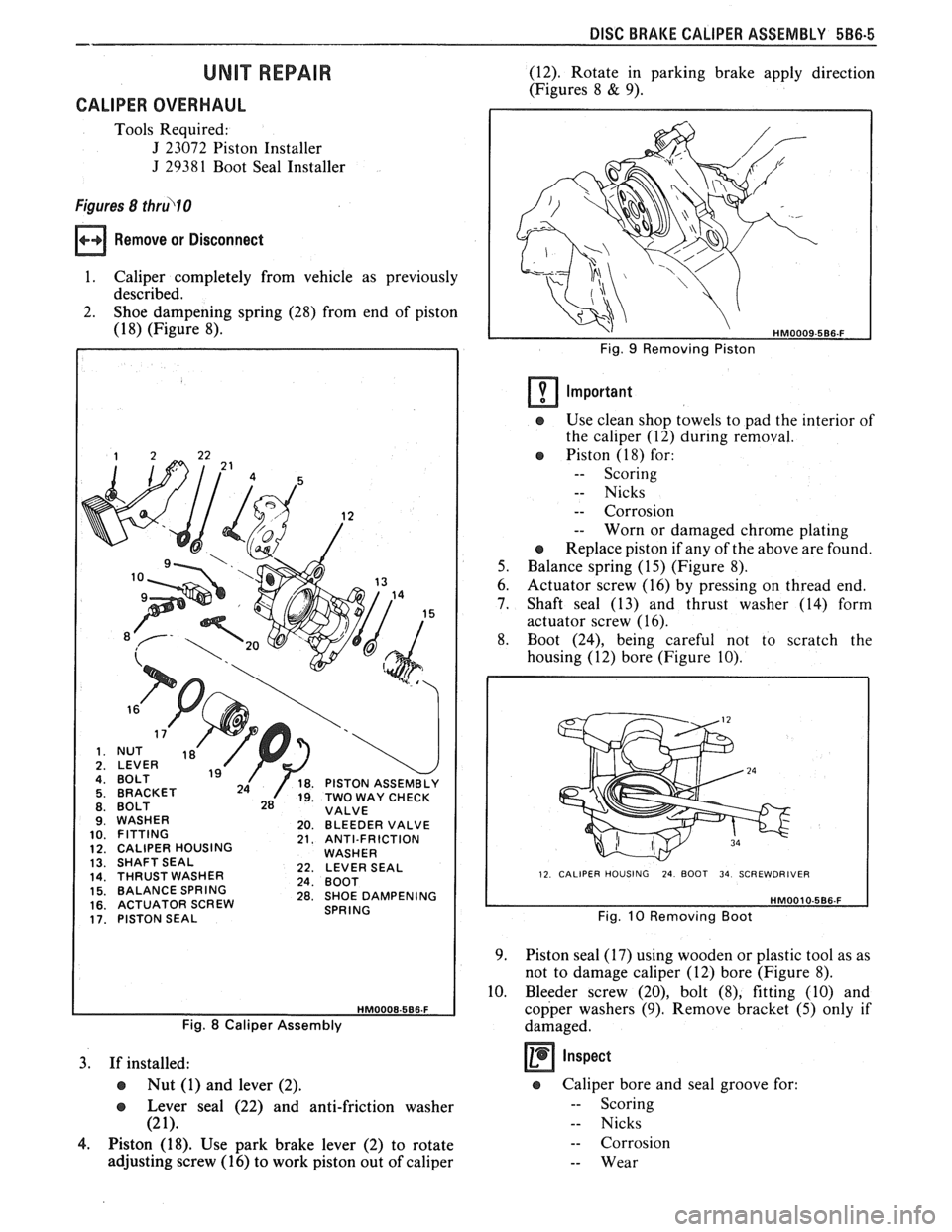
DISC BRAKE CALIPER ASSEMBLY 586.5 --
UNIT REPAIR
CALIPER OVERHAUL
Tools Required:
J 23072 Piston Installer
J 2938 1 Boot Seal Installer
Figures 8 thru'l0
Remove or Disconnect
1. Caliper completely from vehicle as previously
described.
2. Shoe dampening spring (28) from end of piston
(18) (Figure 8).
2. LEVER 4. BOLT
5. BRACKET
8. BOLT
9. WASHER
20. BLEEDER VALVE
10. FITTING
21. ANTI-FRICTION
12. CALIPER HOUSING
WASHER
13. SHAFT SEAL
22. LEVER SEAL
14. THRUST WASHER
15. BALANCE SPRING 24. BOOT
16. ACTUATOR SCREW 28.
SHOE DAMPENING
17. PISTON SEAL SPRING
Fig. 8 Caliper
Assembly
3. If installed:
a Nut (1) and lever (2).
a Lever seal (22) and anti-friction washer
(21).
4. Piston (18). Use park brake lever (2) to rotate
adjusting screw (16) to work piston out of caliper (12).
Rotate in parking brake apply direction
(Figures 8
& 9).
Fig. 9 Removing Piston
Important
a Use clean shop towels to pad the interior of
the caliper (12) during removal.
Piston (18) for:
-- Scoring
-- Nicks
-- Corrosion -- Worn or damaged chrome plating
e Replace piston if any of the above are found.
5. Balance spring (15) (Figure 8).
6. Actuator screw (16) by pressing on thread end.
7. Shaft seal (13) and thrust washer (14) form
actuator screw (16).
8. Boot
(24), being careful not to scratch the
housing (12) bore (Figure 10).
1
12 CALIPER HOUSING 24 BOOT 34 SCREWDRIVER
I
Fig. 10 Removing Boot
9.
Piston seal (17) using wooden or plastic tool as as
not to damage caliper (12) bore (Figure 8).
10. Bleeder screw
(20), bolt (8), fitting (10) and
copper washers (9). Remove bracket
(5) only if
damaged.
Inspect
Caliper bore and seal groove for:
-- Scoring
-- Nicks
-- Corrosion
-- Wear
Page 327 of 1825
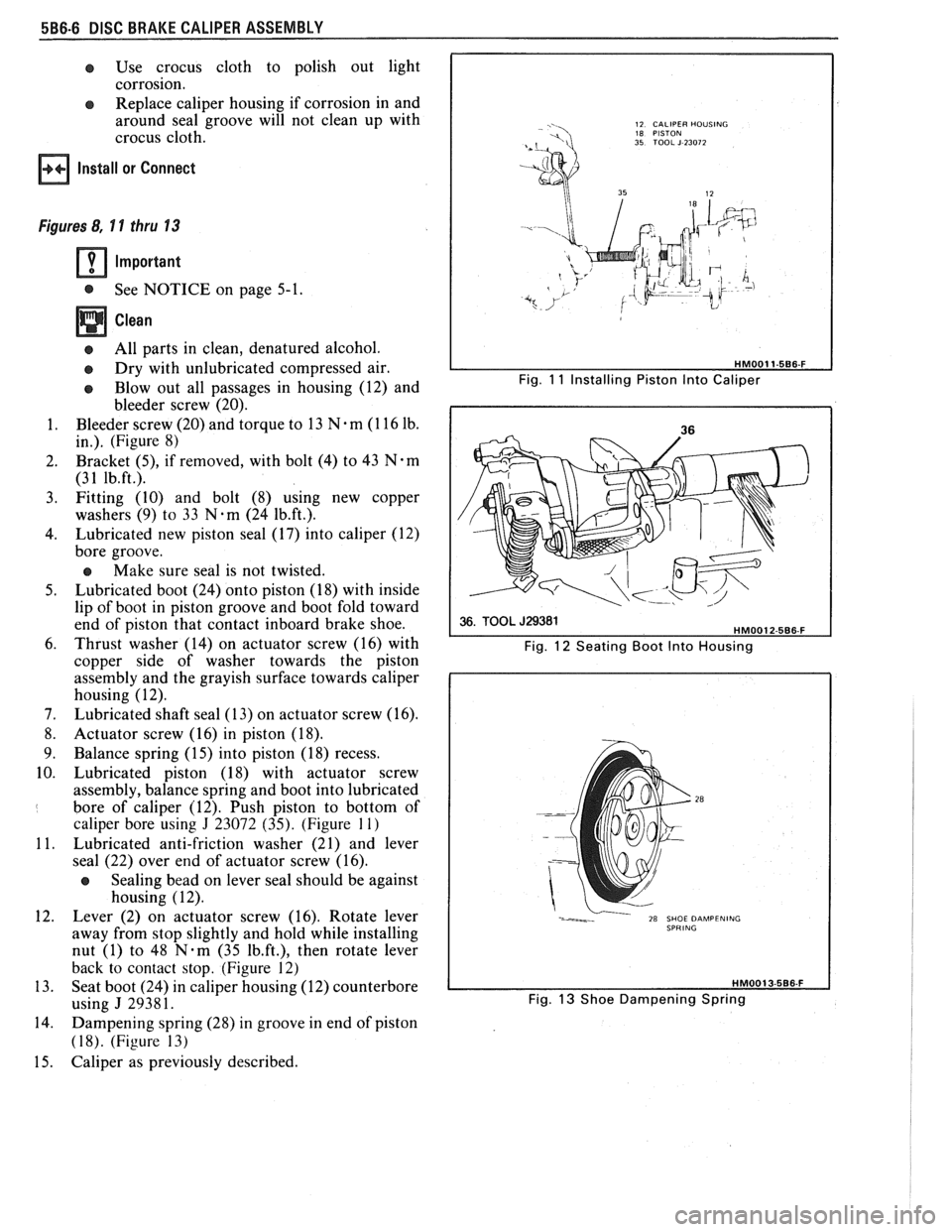
5B6-6 DISC BRAKE CALIPER ASSEMBLY
e Use crocus cloth to polish out light
corrosion.
e Replace caliper housing if corrosion in and
around seal groove will not clean up with
crocus cloth.
Install or Connect
Figures 8, 1 1 thru 13
Important - @ See NOTICE on page 5-1,
e All parts in clean, denatured alcohol.
e Dry with unlubricated compressed air.
e Blow out all passages in housing (12) and
bleeder screw (20).
Bleeder screw (20) and torque to 13 N
. m (1 16 lb.
in.). (Figure
8)
Bracket (5), if removed, with bolt (4) to 43 N-m
(3 1 1b.ft.).
Fitting (10) and bolt (8) using new copper
washers (9) to 33
N-m (24 1b.ft.).
Lubricated new piston seal (17) into caliper (12)
bore groove.
a Make sure seal is not twisted.
Lubricated boot (24) onto piston (1 8) with inside
lip of boot in piston groove and boot fold toward
end of piston that contact inboard brake shoe.
Thrust washer (14) on actuator screw (16) with
copper side of washer towards the piston
assembly and the grayish surface towards caliper
housing (12).
Lubricated shaft seal (13) on actuator screw (16).
Actuator screw (16) in piston (18).
Balance spring (15) into piston (18) recess.
Lubricated piston (18) with actuator screw
assembly, balance spring and boot into lubricated
bore of caliper (12). Push piston to bottom of
caliper bore using
J 23072 (35). (Figure 11)
Lubricated anti-friction washer (2 1) and lever
seal (22) over end of actuator screw (16).
a Sealing bead on lever seal should be against
housing
( 12).
Lever (2) on actuator screw (16). Rotate lever
away from stop slightly and hold while installing
nut (1) to 48
N-m (35 Ib.ft.), then rotate lever
back to contact stop. (Figure 12)
Seat boot (24) in caliper housing (12) counterbore
using
J 29381.
Dampening spring (28) in groove in end of piston
(1 8). (Figure 13)
Caliper as previously described.
12 CALIPER HOUSING
18 PISTON
35 TOOL J 23072
Fig. 11 Installing Piston lnto Caliper
Fig.
12 Seating Boot lnto Housing
Fig.
13 Shoe Dampening Spring
Page 328 of 1825
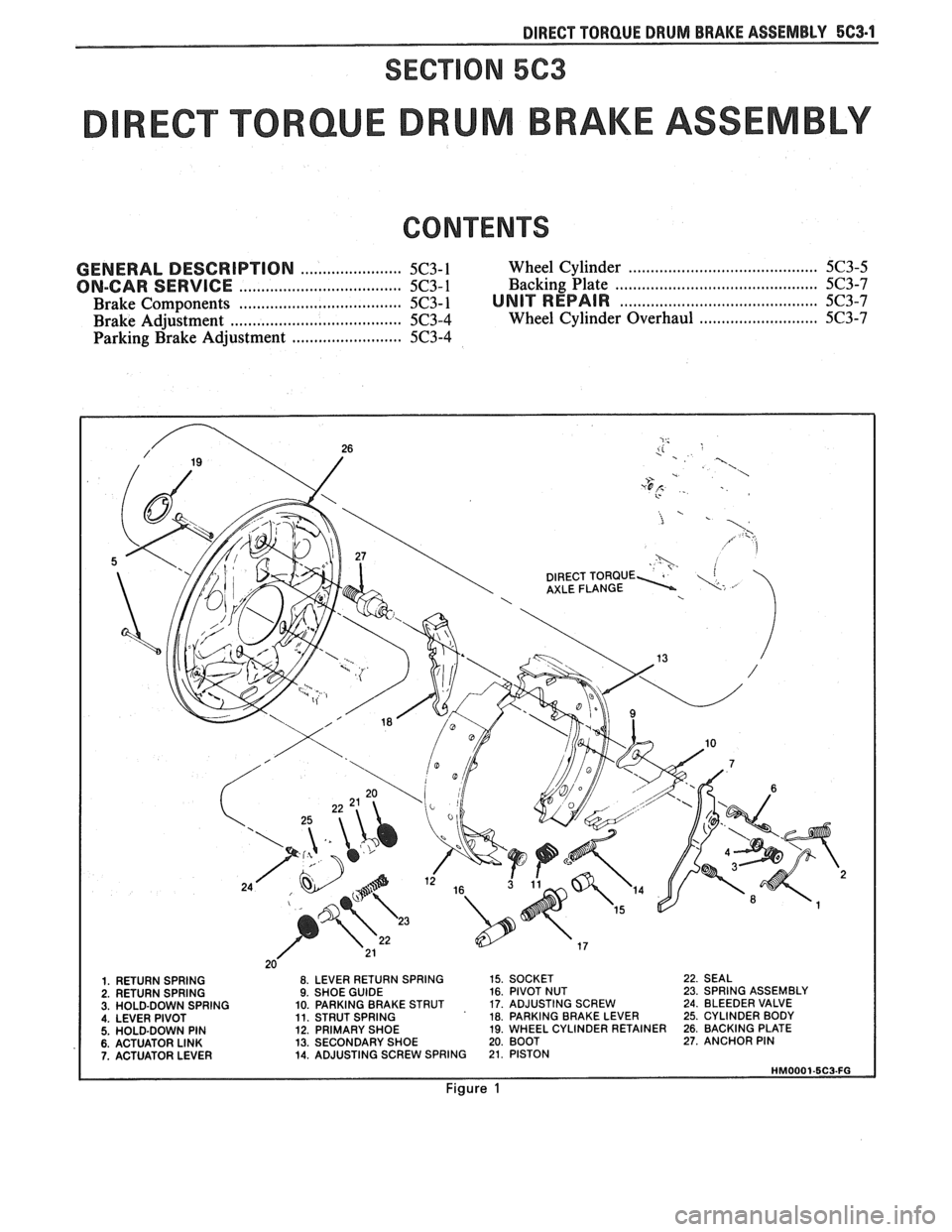
DIRECT TORQUE DRUM BRAKE ASSEMBLY 5C3-1
SECTION 5C3
RECT TORQUE DRUM BRAKE ASSEMBLY
CONTENTS
GENERAL DESCRIPTION ....................... 5C3-1 Wheel Cylinder ........................................ 5C3-5
ON-CAR SERVICE ................................... 5C3-1 Backing Plate ............................................ 5C3-7
Brake Components ................... .... ......... 5C3- 1 UNIT REPAIR ........................................... 5C3-7
Brake Adjustment ..................................... 5C3-4 Wheel Cylinder Overhaul .......................... 5C3-7
Parking Brake Adjustment ......................... 5C3-4
1. RETURN SPRING 8. LEVER RETURN SPRING 15. SOCKET 22. SEAL 2. RETURN SPRING 9. SHOE GUIDE 16. PIVOT NUT 23. SPRING ASSEMBLY 3. HOLD-DOWN SPRING 10. PARKING BRAKE STRUT . 17. ADJUSTING SCREW 24. BLEEDER VALVE 4. LEVER PIVOT 11. STRUT SPRING 18. PARKING BRAKE LEVER 25. CYLINDER BODY 5. HOLD.DOWN PIN 12. PRIMARY SHOE 19. WHEEL CYLINDER RETAINER 26. BACKING PLATE 6. ACTUATOR LINK 13. SECONDARY SHOE 20. BOOT 27. ANCHOR PIN 7. ACTUATOR LEVER 14. ADJUSTING SCREW SPRING 21. PISTON HM0001.5C3-FG
Figure 1
Page 329 of 1825
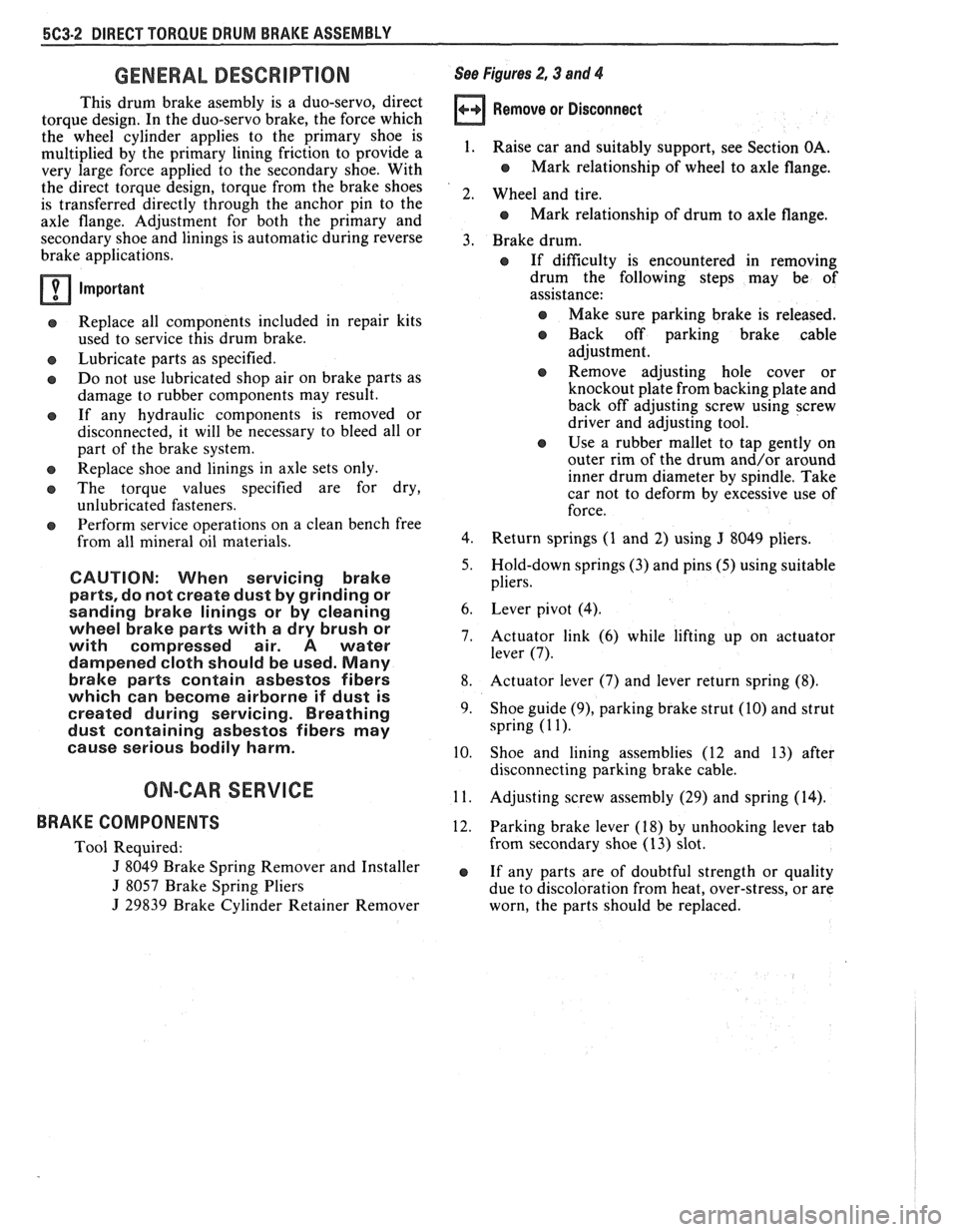
5C3-2 DIRECT TORQUE DRUM BRAKE ASSEMBLY
GENERAL DESCRIPTION
This drum brake asembly is a duo-servo, direct
torque design. In the duo-servo brake, the force which
the wheel cylinder applies to the primary shoe is
multiplied by the primary lining friction to provide a
very large force applied to the secondary shoe. With
the direct torque design, torque from the brake shoes
is transferred directly through the anchor pin to the
axle flange. Adjustment for both the primary and
secondary shoe and linings is automatic during reverse
brake applications.
Important
a Replace all components included in repair kits
used to service this drum brake.
a Lubricate parts as specified.
e Do not use lubricated shop air on brake parts as
damage to rubber components may result.
a If any hydraulic components is removed or
disconnected, it will be necessary to bleed all or
part of the brake system.
s Replace shoe and linings in axle sets only.
e The torque values specified are for dry,
unlubricated fasteners.
e Perform service operations on a clean bench free
from all mineral oil materials.
CAUTION: When servicing brake
parts, do not create dust by grinding or
sanding brake linings or by cleaning
wheel brake parts with a dry brush or
with compressed air.
A water
dampened cloth should be used.
Many
brake parts contain asbestos fibers
which can become airborne if dust is
created during servicing. Breathing
dust containing asbestos fibers may
cause serious bodily harm.
ON-CAR SERVICE
BRAKE COMPONENTS
Tool Required:
J 8049 Brake Spring Remover and Installer
J 8057 Brake Spring Pliers
J 29839 Brake Cylinder Retainer Remover
See Figures 2,3 and 4
Remove or Disconnect
1.
Raise car and suitably support, see Section OA.
e Mark relationship of wheel to axle flange.
2. Wheel and tire.
e Mark relationship of drum to axle flange.
3. Brake drum.
a If dificulty is encountered in removing
drum the following steps may be of
assistance:
@ Make sure parking brake is released.
a Back off parking brake cable
adjustment.
a Remove adjusting hole cover or
knockout plate from backing plate and
back off adjusting screw using screw
driver and adjusting tool.
a Use a rubber mallet to tap gently on
outer rim of the drum and/or around
inner drum diameter by spindle. Take
car not to deform by excessive use of
force.
4. Return springs (1 and 2) using
J 8049 pliers.
5. Hold-down springs (3) and pins (5) using suitable
pliers.
6. Lever pivot (4).
7. Actuator link (6) while lifting up on actuator
lever
(7).
8. Actuator lever (7) and lever return spring (8).
9.
Shoe guide (9), parking brake strut (10) and strut
spring
(1 1).
10. Shoe and lining assemblies (12 and 13) after
disconnecting parking brake cable.
11. Adjusting screw assembly (29) and spring (14).
12. Parking brake lever (18) by unhooking lever tab
from secondary shoe (13) slot.
e If any parts are of doubtful strength or quality
due to discoloration from heat, over-stress, or are
worn, the parts should be replaced.
Page 330 of 1825
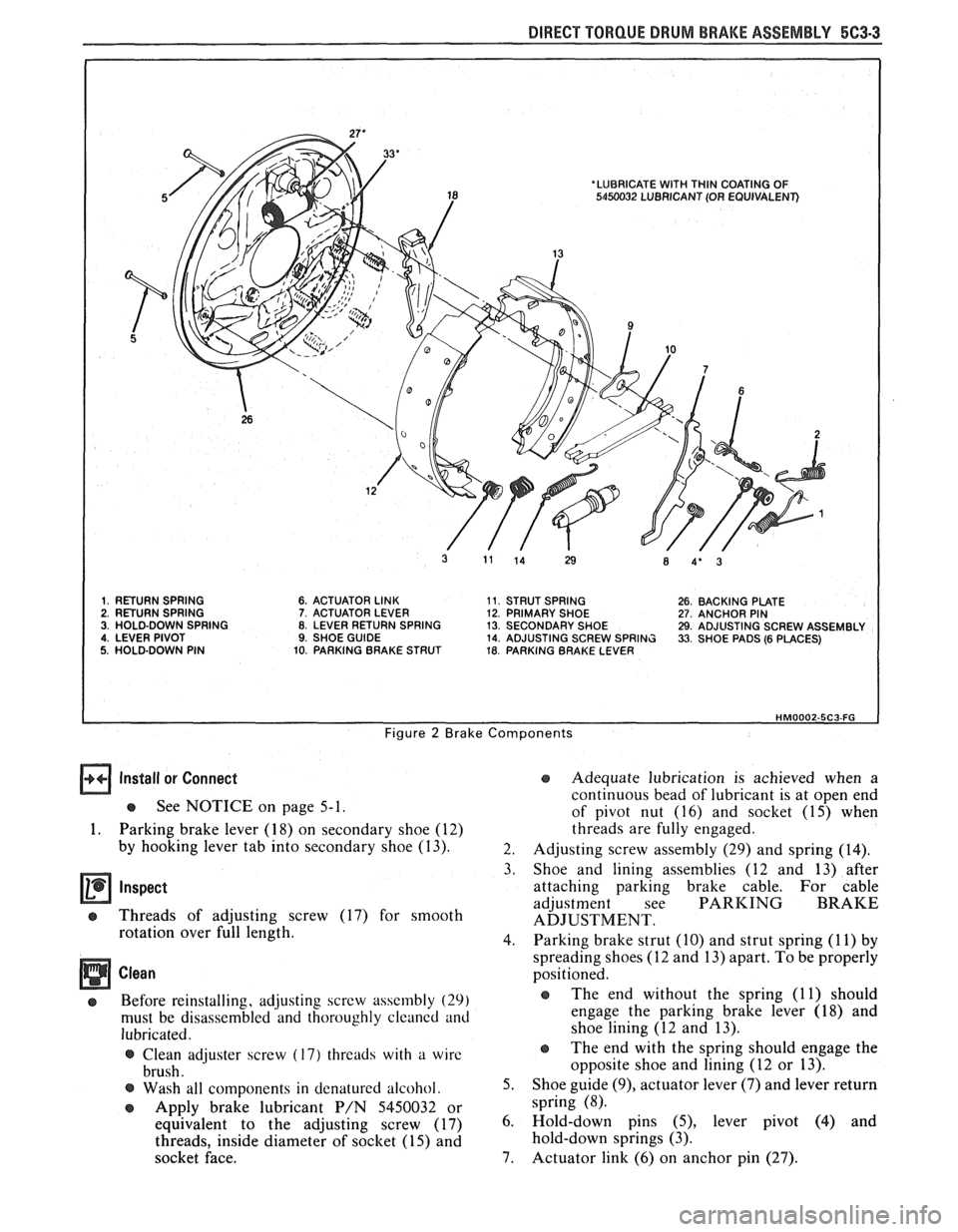
DIRECT TORQUE DRUM BRAKE ASSEMBLY 5C3-3
1. RETURN SPRING 6. ACTUATOR LINK 11. STRUT SPRING 26. BACKING PLATE 2. RETURN SPRING 7. ACTUATOR LEVER 12. PRIMARY SHOE 27. ANCHOR PIN 3. HOLD-DOWN SPRING 8. LEVER RETURN SPRING 13. SECONDARY SHOE 29. ADJUSTING SCREW ASSEMBLY 4. LEVER PIVOT 9. SHOE GUIDE 14. ADJUSTING SCREW SPRING 37 SHOE PADS (6 PLACES) 5. HOLD-DOWN PIN 10. PARKING BRAKE STRUT 18. PARKING BRAKE LEVER
Figure 2 Brake Components
Install or Connect
e See NOTICE on page 5-1.
1. Parking brake lever (18) on secondary shoe (12)
by hooking lever tab into secondary shoe (13).
o Threads of adjusting screw (17) for smooth
rotation over full length.
Clean
e Before reinstalling, adjusting screw asse~nbly (29)
must be disassembled and thoroughly cleaned and
lubricated.
@ Clean adjuster screw ( 17) threads with a wire
brush.
@ Wash all components in denatured alcohol.
o Apply brake lubricant P/N 5450032 or
equivalent to the adjusting screw (17)
threads, inside diameter of socket (15) and
socket face.
e Adequate lubrication is achieved when a
continuous bead of lubricant is at open end
of pivot nut (16) and socket (15) when
threads are fully engaged.
2. Adjusting screw assembly (29) and spring
(14).
3. Shoe and lining assemblies (12 and 13) after
attaching parking brake cable. For cable
adjustment see
PARKING BRAKE
ADJUSTMENT.
4. Parking brake strut (10) and strut spring
(1 1) by
spreading shoes (12 and 13) apart. To be properly
positioned.
o The end without the spring (11) should
engage the parking brake lever (18) and
shoe lining (12 and 13).
e~ The end with the spring should engage the
opposite shoe and lining (12 or 13).
5. Shoe guide
(9), actuator lever (7) and lever return
spring
(8).
6. Hold-down pins (5), lever pivot (4) and
hold-down springs (3).
7. Actuator link (6) on anchor pin (27).